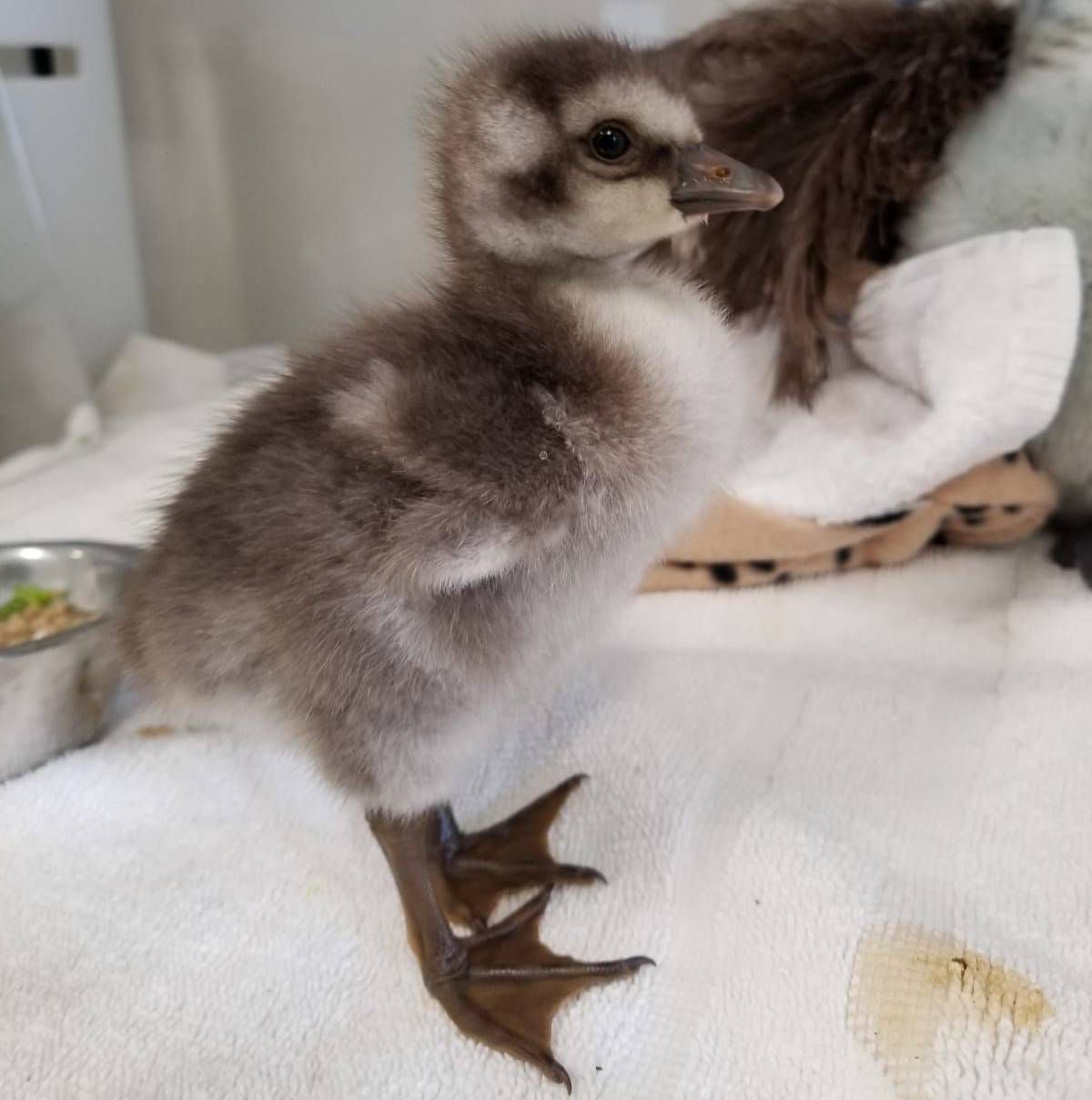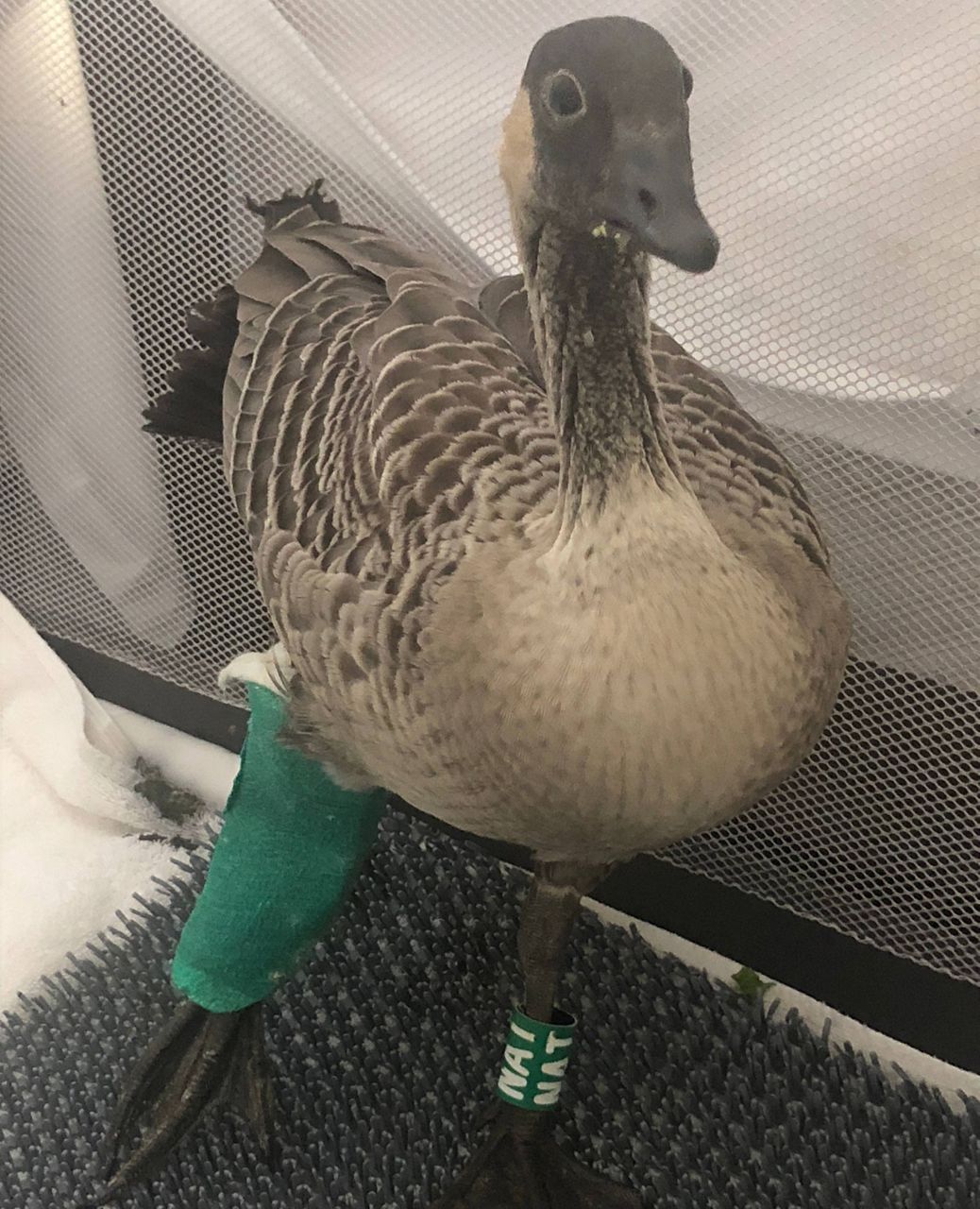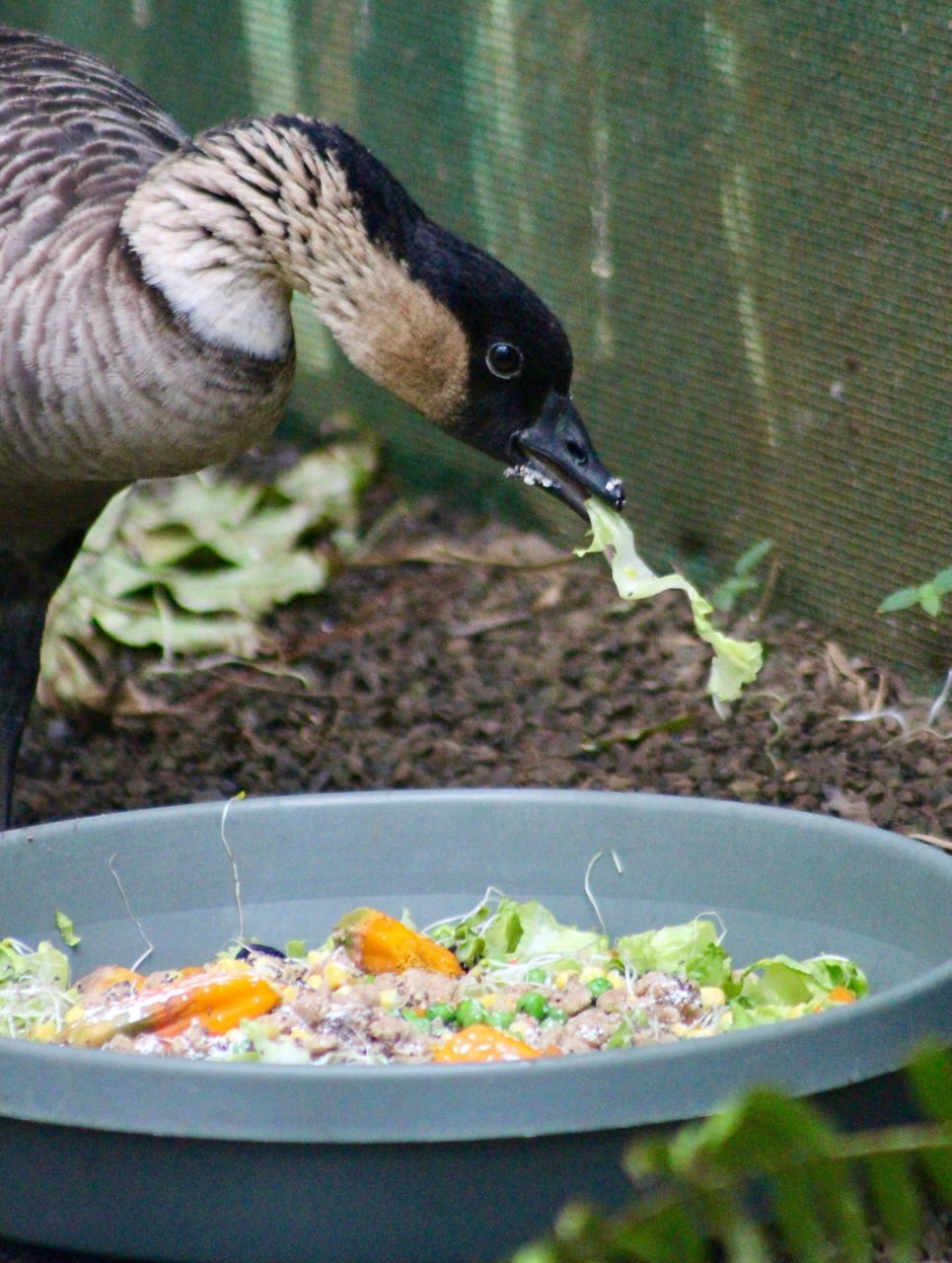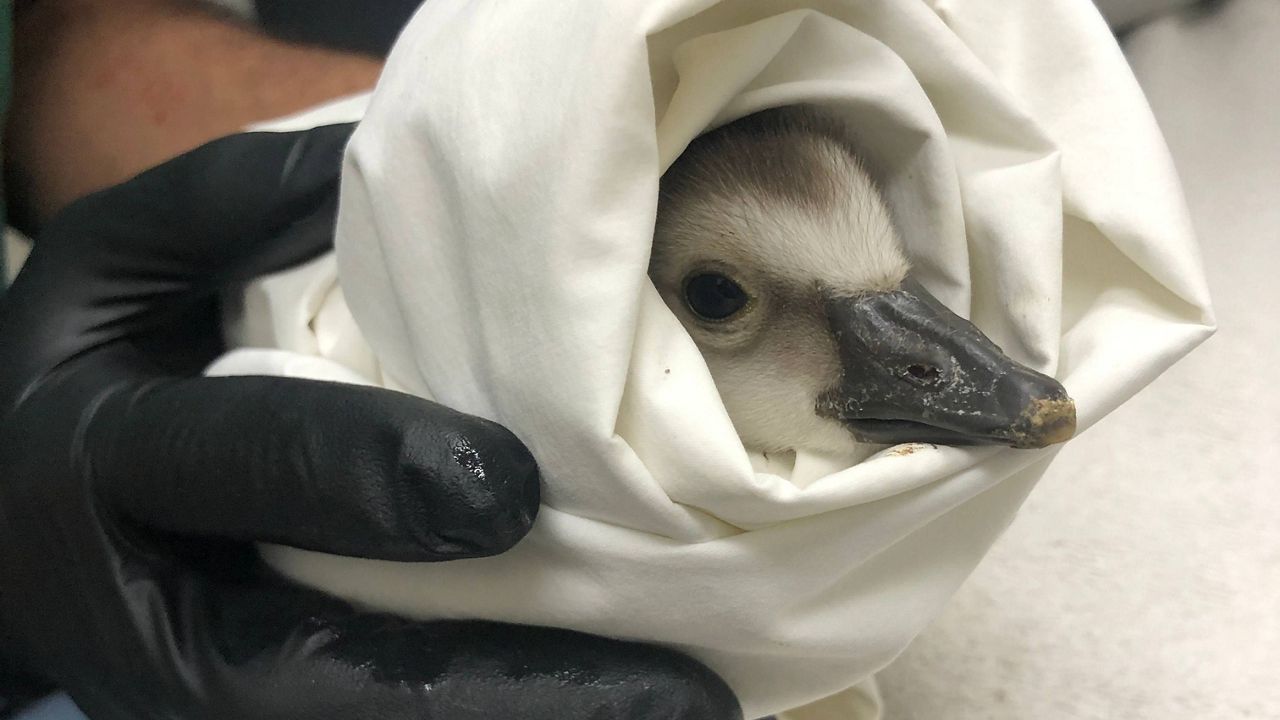Nene have a surprising killer: golf balls. As the state bird’s population has increased, many have congregated at golf courses, where they enjoy the manicured lawns, but their high numbers on the green have led to many injuries and even death.
The nene, or Hawaiian goose, is endemic to Hawaii. In 1952, there were only 30 nene remaining, but since then the birds have made a comeback — with 3,000 nene now roaming Hawaii Island, Kauai, Maui and Molokai. However, when Captain James Cook arrived in 1778, an estimated 25,000 nene roamed the islands.
“They're not out of the woods, but they're definitely going in the right direction,” the President of the Hawaii Wildlife Center Linda Elliott said to Spectrum News Hawaii about the nene population. The Hawaii Wildlife Center on Hawaii Island is one of only two rehabilitation centers in the state that takes in nene, and they also care for nene that are flown in from other islands.
In the last 10 years, the nene population has made significant strides, and the population of nene on Hawaii Island had a major boon in 2011 when 600 birds were translocated from Kauai to Hawaii Island. The birds were breeding at a Kauai resort that was right next to the Lihue airport and were often found on the runways.
Why nene love golf courses
Nene can be found all over the islands, but on Hawaii Island they often gather at golf courses, where they enjoy eating grass, especially the new tips.
“They would move from upland to lowland, based on the food resources. In the upland, they eat berries; in the lowland, they enjoy grass, especially eating the new tips,” Elliott said.
“It's a real draw for nene to come to the golf courses, where the grasses are being watered regularly and maintained and the new tips are really the most nutritious,” Elliott added.
Raymond McGuire, a DOFAW wildlife biologist, who works with nene, told Spectrum News that along with the “constantly mowed and manicured” grass, nene love golf courses because of the ponds. “By far, nene prefer golf courses.”
He also noted that on Hawaii Island many of the golf courses are built atop lava flows on the dry side of the island. “If there weren’t golf courses, there wouldn’t be a habitat for the nene.”
These modified, lowland areas are very attractive to nene, where they are now flourishing.

How nene get hurt at golf courses
“They weren't raised with golf courses; they don't know what the hazards are,” said Elliott.
On golf courses, balls, carts and even lawn mowers hit nene.
“When golfers are playing, nene can either fly to the field or wander on the field at an inopportune moment and be hit,” Elliott explained. “Golf carts going at high speed might accidentally clip one of them or mowing machines have to keep an eye out for them.”
McGuire said nene are becoming comfortable around humans because people feed them.
“When we talked to people about it, they usually say that the nene runs in front of them,” said McGuire about golf cart collisions. “Like other animals, if they get frightened, they sometimes run in the wrong direction.”
Usually when nene are injured, it's an accident, but there have been some purposeful attacks. In particular, McGuire cites the case of a German tourist who was convicted for killing a nene at the Mauna Kea Golf Course, sentenced to one year of probation and forced to pay a $11,000 fine. He reportedly swung his golf club at a nene and then ran it over with a golf cart. In court, he said his wife had been afraid of the goose.
During nesting season, which runs from October until March, nene are especially vulnerable, as they lay on their nests and watch their goslings. After the birds breed, they also molt and cannot fly. McGuire noted people might not realize that the birds are flightless, expecting that they’ll get out of the way before a high-speed ball flies through the air and hits them.
Elliott said these injuries are becoming more common. So far in 2022, about 40 nene have been injured on golf courses across the state. “That’s a large number — and a significant impact for the nene and also for the care at our facility.”
In 2021, McGuire said he worked with 21 nene that came directly from a golf course, and that they picked up another 11 dead nene from golf courses.
“We really do see a lot of injuries coming from golf courses, mainly because that's where the nene are,” said McGuire.

What happens to injured nene
Elliott, who is the president of Hawaii Wildlife Center, which does nene rehabilitation, said golf balls cause serious injuries, including compound fractures to their wings and legs, as well as head trauma and body bruising.
“Nobody wants to get hit by a golf ball — it causes a lot of damage,” said Elliott. “They do take a lot of medical and rehabilitative care, if they are treatable, if we're able to get them in time.”
In order to help nene, they are first brought to the Hawaii Wildlife Center’s hospital. The nonprofit runs a program called Wheels For Wildlife, where volunteers help bring the animals from golf courses to the hospital, or if the birds are coming for another island, then from the airport to the hospital. The Hawaii Wildlife Center is open around the clock, seven days a week. Upon arrival, the wildlife hospital staff evaluates the injured nene.
“The team takes them to a full exam. They do diagnostics, x-rays and blood work to find out their overall condition and then they’re set up for treatment if it requires surgery,” said Elliott.
When necessary, orthopedic surgeons on Oahu and Maui work with the Hawaii Wildlife Center to set bones.
After the exam is finished, the rehab work begins.
“For bones to heal, it takes weeks to several months,” said Elliott.
The birds receive physical therapy, medication to prevent infections and treat pain, and nutritional care.
“We provide them ‘nene salads’ that are quite lovely — they look like something you’d want to order,” said Elliott.
When the nene are ready, they move from the hospital to aviaries to prepare them for being released back into the wild.
“When they're fully healthy again, when their injury has resolved, then they are released back into the wild,” said Elliott.

How to help
Elliott asks golfers and others on golf courses to keep an eye out for nene. She recommends that when a nene is spotted, golfers should give themselves a deduction or reward themselves for moving through the area. “Instead of an eagle, they can call it a nene,” said Elliott.
If a nene gets hit, Elliott asks golfers or golf course staff to call the Hawaii Wildlife Center or the Division of Forestry and Wildlife, who will help retrieve the nene for rehabilitation. The two agencies work in partnership on Hawaii Island. For those on Kauai, Save Our Shearwaters is a rehabilitation center for nene that works with the Division of Forestry and Wildlife.
“We need funding support, to give all that care, to the nene to get them healthy and back out into the wild,” said Elliott. For those interested in donating, they can find more information here.
Others who want to assist can also volunteer to work for Wheels For Wildlife, which operates on all the islands, and Elliott said they can always use more volunteers.
McGuire said all the golf courses where nene have been injured are cooperative and always ask what they can do to help. He recommends that golf courses put up signs and educate golfers by informing them that nene are a protected species and to give them space.
When nene nest in areas that are of concern, the golf courses will put construction fencing around them for protection, according to McGuire. Since the nene are protected, the golf courses are not allowed to move them.
Spectrum News asked Waikoloa Golf Course, which is well-known for having nene on its premises, how they are mitigating nene injuries.
“Waikoloa Land Company is deeply committed to protecting all of the native plants and animals that call Waikoloa home. Numerous conservation programs, educational resources and close coordination with federal, state and local partners ensure the preservation of these precious species,” the golf course said in a statement.
As for individuals, McGuire emphasized the people should not feed the nene. “Don't try to entice the nene to come to you, don't habituate the nene. They're not pets, they're wildlife.”
“As the nene population increases, they'll be encroaching into our human spaces, our golf courses and our parks,” McGuire. “The biggest take home with that is, we have to live together, we have to figure out a way for the nene to get along with humans and humans to get along with nene. And that really boils down to we have to respect each other's space.”
Michelle Broder Van Dyke covers the Hawaiian Islands for Spectrum News Hawaii.



